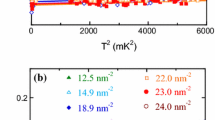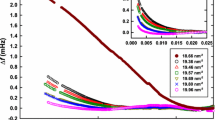Abstract
Recent experiments show that high-coverage4He monolayers adsorbed on graphite have low-temperature heat capacities corresponding to two-dimensional solids. At higher temperatures the solid phase appears to “melt” by a continuous process, suggesting a connection with the theoretical prediction that there can be no long-range crystalline order at finiteT in two-dimensional systems governed by typical interatomic forces. This paper explores the theory in greater detail, with attention to long-range and short-range order and their experimental implications. Several models are studied: two-dimensional harmonic solids with “Debye” phonon spectra, lattices with Van Hove singularities, two-dimensional quantum solids, and effects of periodic potentials due to substrate structure. The theory is discussed in the light of current understanding of melting, and the following new melting hypothesis is proposed.
-
1.
The solid-liquid transition occurs on a mode-by-mode basis, beginning with the lowest wave vectors.
-
2.
Solid instability is primarily associated with transverse modes.
-
3.
A mode becomes unstable when the range of crystalline order becomes comparable with its wavelength.
Applied to two-dimensional systems, the hypothesis predicts a continuous transition with a heat-capacity contribution similar in its temperature dependence to the anomalies seen in4He monolayers and N2 multilayers. Applied to three-dimensional Debye solids, the same hypothesis predicts an abrupt first-order process, with a melting temperature obeying the Lindemann law.
Similar content being viewed by others
References
M. Bretz, G. B. Huff, and J. G. Dash,Phys. Rev. Letters 28, 729 (1972).
R. E. Peierls,Ann. Inst. Henri Poincare 5, 177 (1935).
L. D. Landau,Phys. Z. Sowjetunion 11, 26 (1937).
B. Jancovici,Phys. Rev. Letters 19, 20 (1967).
L. Gunther,Phys. Letters 25A, 649 (1967); errata26A, 216 (1968).
N. D. Mermin,Phys. Rev. 176, 250 (1968).
Y. Imry and L. Gunther,Phys. Rev. B3, 2555 (1970).
J. F. Fernandez.Phys. Rev. A2, 2555 (1970).
E. Jahnke and F. Emde,Tables of Functions (Dover, New York, 1945).
L. Van Hove,Phys. Rev. 89, 1189 (1953).
E. W. Montroll,J. Chem. Phys. 15, 575 (1947).
S. C. Ying,Phys. Rev. B3, 4160 (1971).
F. Ricca, C. Pisani, and E. Garrone,J. Chem. Phys. 51, 4079 (1969).
A. D. Novaco and F. J. Milford,J. Low Temp. Phys. 3, 307 (1969).
H. W. Lai, C. W. Woo, and F. Y. Wu,J. Low Temp. Phys. 3, 463 (1970).
D. E. Hagen, A. D. Novaco, and F. J. Milford,Proc. Second Int. Symposium on Adsorption-Desorption Phenomena (Academic Press, New York, to be published).
M. Bretz and J. G. Dash,Phys. Rev. Letters 26, 963 (1971).
G. Ahlers,Phys. Rev. A2, 1505 (1970).
D. O. Edwards, A. S. McWilliams, and J. G. Daunt,Phys. Letters 1, 101 (1962).
M. Bretz and J. G. Dash,Phys. Rev. Letters 27, 647 (1971).
J. A. Morrison and L. E. Drain,J. Chem. Phys. 19, 1063 (1951).
J. A. Morrison, L. E. Drain, and J. S. Dugdale,Can. J. Chem. 30, 890 (1952).
K. S. Dennis, E. L. Pace, and C. S. Baughman,J. Am. Chem. Soc. 75, 3269 (1953).
C. Domb and J. S. Dugdale, inProgress in Low Temperature Physics, C. J. Gorter, ed. (North-Holland, Amsterdam, 1957), Vol. 2, Chap. 11.
F. A. Lindemann,Z. Physik 11, 609 (1910).
D. Pines,Elementary Excitations in Solids (W. A. Benjamin, New York, 1963), pp. 34–37.
J. Frenkel,Kinetic Theory of Liquids (Oxford University Press, London, 1946), Chap. 3.
M. Born,J. Chem. Phys. 7, 591 (1939).
W. Shockley,Rep. 9th Solvay Congress 1951, p. 431.
B. J. Alder, W. G. Hoover, and T. E. Wainwright,Phys. Rev. Letters 11, 241 (1963).
B. J. Alder, W. R. Gardner, J. K. Hoffer, N. E. Phillips, and D. A. Young,Phys. Rev. Letters 21, 732 (1968).
J. O. Hirschfelder, C. F. Curtiss, and R. B. Bird,Molecular Theory of Gases and Liquids (John Wiley & Sons, New York, 1954), p. 285.
Author information
Authors and Affiliations
Additional information
Research supported by the National Science Foundation.
Rights and permissions
About this article
Cite this article
Dash, J.G., Bretz, M. Short-range order and melting anomalies in thin films. J Low Temp Phys 9, 291–306 (1972). https://doi.org/10.1007/BF00654848
Received:
Issue Date:
DOI: https://doi.org/10.1007/BF00654848




